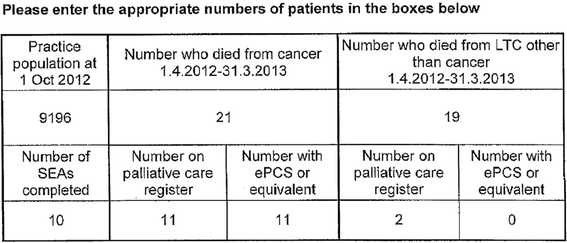Improving primary palliative care in Scotland: lessons from a mixed methods study
- PMID: 26651488
- PMCID: PMC4676155
- DOI: 10.1186/s12875-015-0391-x
Improving primary palliative care in Scotland: lessons from a mixed methods study
Abstract
Background: Since 2012, all GP practices across Scotland have been supported to take a systematic approach to end-of-life care, by helping them to identify more patients for palliative care through a Palliative Care Directed Enhanced Service (DES). We aimed to understand the impact of this initiative.
Methods: Routine quantitative data from the 2012/13, and 2013/14 DES were collected from regional health boards, analysed and discussed. Qualitative data were collected from a sample of 2012/13 DES returns and analysed using Thematic Analysis.
Results: Data were received from 512 practices in nine Scottish Health boards for the 2012-13 DES and 638 practices in 11 Health boards for 2013-14. A sample of 90 of the returns for 2012-13 was selected for qualitative analysis. In 2012-13, 72 % of patients who died of cancer were listed on the palliative care register (PCR) before death while 27 % of patients who died as a result of non-malignant conditions were listed on the PCR. In 2013-14, cancer identification remained the same but identification of people dying with other long-term conditions had improved to 32.5 %. We identified several key issues needed to improve palliative care in the community. The need for training to identify patients with palliative care needs (particularly non-cancer); communication skills training; improvements in sharing information across the NHS; under-resource of and lack of coordination with district nurses; improvements in information technology; and tools for working with enlarged palliative care registers.
Conclusions: The DES helped more patients with long-term conditions (LTC) receive generalist palliative care. Approaching generalist palliative care as anticipatory care could facilitate communication between GPs and patients/families and remove some barriers to early identification of palliative care needs. Improvement of information technology and use of identification tools like the SPICT™ may improve professionals' communication with each other and help may make identification and management of patients easier.
Figures
References
-
- Gómez-Batiste X, Martínez-Muñoz M, Blay C, Amblàs J, Vila L, Costa X, et al. Identifying patients with chronic conditions in need of palliative care in the general population: development of the NECPAL tool and preliminary prevalence rates in Catalonia. BMJ Support Palliat Care. 2013;3(3):300–308. doi: 10.1136/bmjspcare-2012-000211. - DOI - PubMed
-
- Zheng L, Finucane AM, Oxenham D, McLoughlin P, McCutcheon H, Murray SA. How good is primary care at identifying patients who need palliative care? A mixed methods study. Eur J Palliat Care. 2013;20(5):216–222.
Publication types
MeSH terms
LinkOut - more resources
Full Text Sources
Other Literature Sources
Medical



